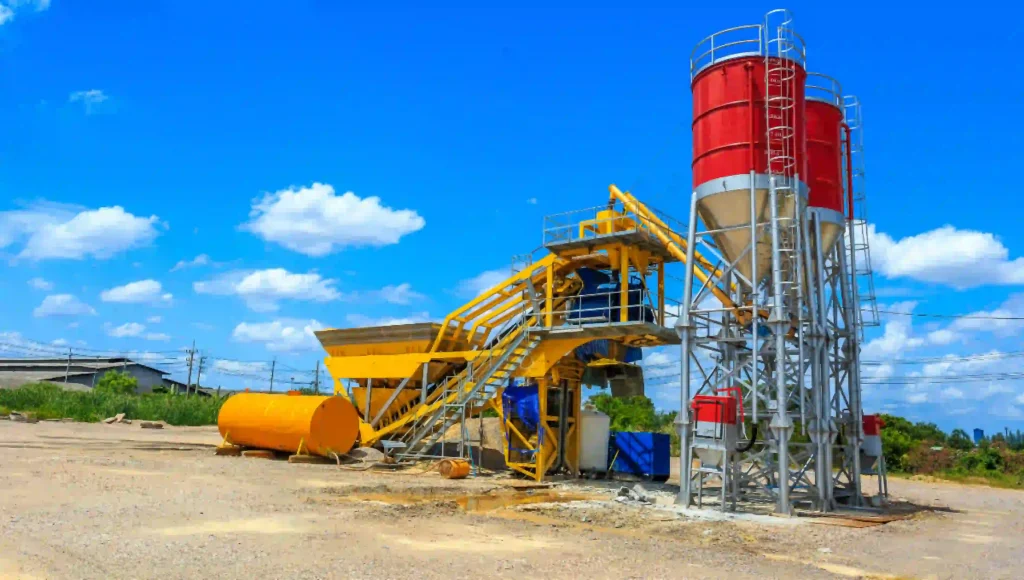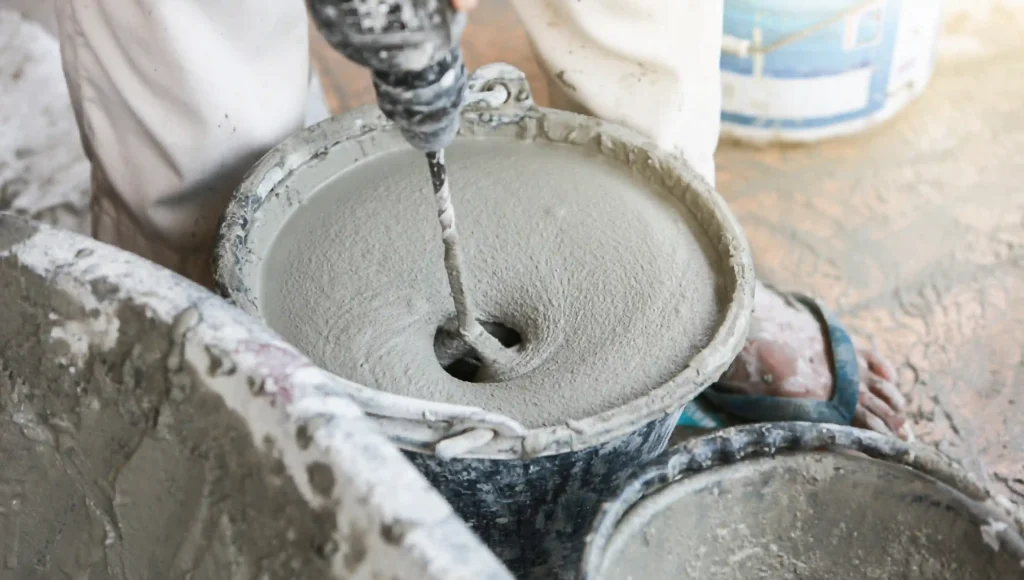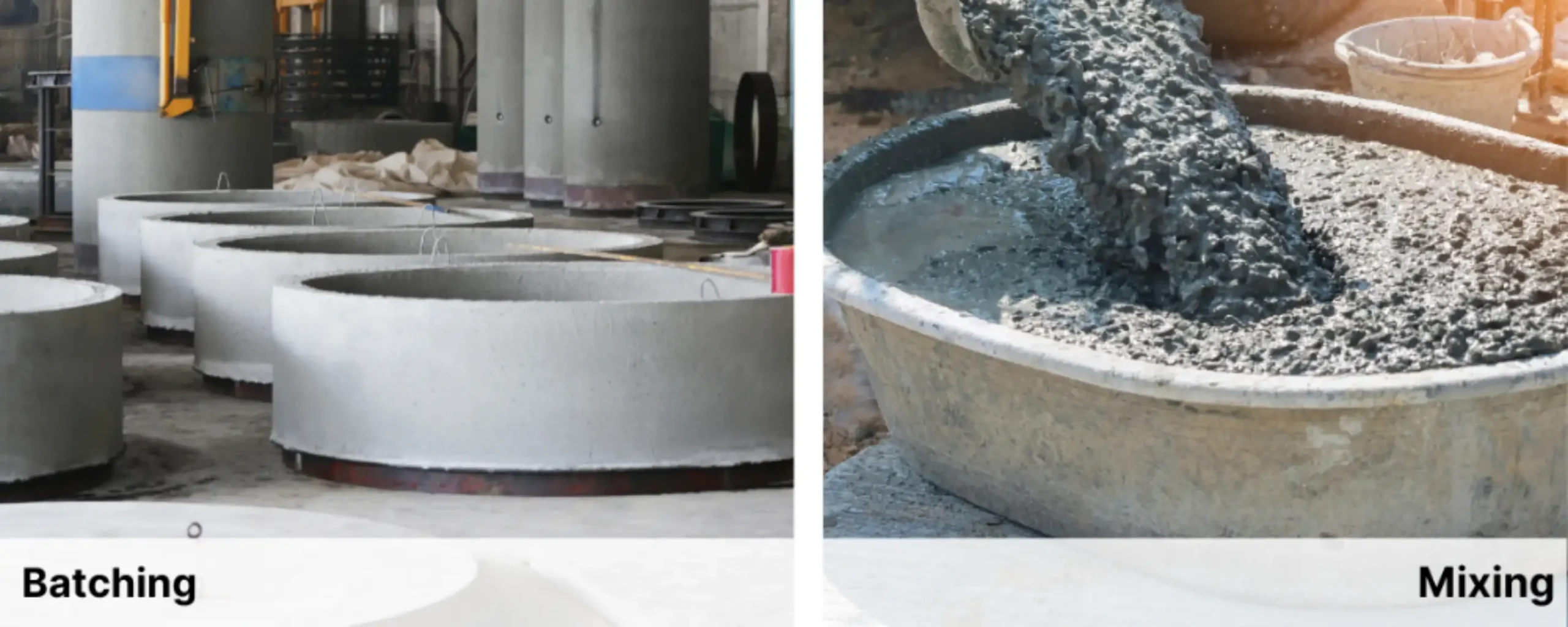Essentially, concrete production consists of two very important processes: batching and mixing. These methods ensure that the concrete used in most buildings, roads, and bridges is strong, durable, and well-done. Let’s take a closer look at what batching and mixing involve and how they differ from each other.
Batching: What Is Batching?

Batching refers to the process of estimating the amount of concrete required for a given construction project and measuring the ingredients in the required proportions needed for the concrete mixture. Some of the materials used in concrete preparation are cement, water, and aggregates, which typically consist of sand and gravel. Occasionally, admixtures, which are special chemicals that enhance concrete characteristics, are also used. Batching can be done in two ways:
- By Volume: the measurement of the ingredients by volume.
- By Mass: It can be measured by weighing the ingredients.
At present, most concretes are batched by mass because of their fair degree of accuracy. In the quest for good concrete, there is a need to measure the various materials in a mix to some considerable degree of .
Accuracy in Batching
Here’s how accurately different materials need to be measured:
- Cement:
- If you’re measuring more than 30% of the capacity of a scale, its accuracy should be within 1% of the required weight.
- For small batch sizes (say less than 30% of the scale capacity), accuracy should be within ±4% (+ or – 4%) of the weight to be added.
- Aggregates (like sand and gravel):
- If you’re measuring more than 30% of the scale’s capacity, the accuracy should be within 1%.
- For small batch sizes (capacity less than 30% of full scale) accuracy will be within 3%.
- Water:
- Water is generally measured volumetrically with ±1% accuracy.
- Admixtures:
- For mineral admixtures, or those materials used as a partial replacement for cement, the precision shall be the same as for cement.
- For chemical admixtures (liquids added into the water), the accuracy is the same for water.
Mixing: What is Mixing?

Mixing is the operation of combining all batched ingredients into a uniform and homogeneous mass of concrete. The objectives of mixing are the intimate coat of all particles of the aggregate (like sand and gravel) through cement paste and homogeneous distribution of all ingredients. Such homogeneity is an essential requirement for concrete’s strength and durability.
Mixer Types
Mixers are of many types, each designed according to different kinds of concrete mixes. Some common types are discussed below:
- Tilting Drum Mixer:
- These mixers have a tilting drum to discharge mixed concrete. The internal vanes of the drum (conical or bowl-shaped) are moving to mix the concrete.
- Tilt mixing drums are adaptable for mixes of low workability, i.e., mixes that are stiffer and mixes with big pieces of aggregate.
- Non-Tilting Drum Mixer:
- Concrete is mixed in the drum of this mixer, which must remain horizontal during operation. Discharge is by the insertion of a chute into the drum or by rotating the drum backwards.
- Due to the slower discharge, some segregation or separation of the materials may occur.
- Pan Type Mixer:
- This mixer operates by forcing the materials to mix rather than depending on gravity, as some kinds of drum mixers do.
- Consists of a circular pan, and it rotates with paddles to mix the concrete. The variation in the mixture is not as much in this type of mixer.
- Dual Drum Mixer
- Primarily used for constructing highways, this mixer has two drums arranged in series. The concrete is partially mixed in the first drum and then transferred to the second drum for final mixing, after which it is discharged.
- Continuous Mixers:
- Mixers: These mixers are automatically fed mixers with continuous weigh batching and are used when continuous mixing of large quantities of concrete is required.
Charging the Mixer
Charging the mixer means adding the ingredients to the mixer. These can be added in different sequences, depending on the mixer type and a few concrete mix properties. The typical process is as follows:
- Typically, a small amount of water is added first.
- Next, all the solid materials (such as cement, sand, and gravel) are added.
- Most of the remaining water is added at the same time as the solids, with the rest of the water added after the solids are in the mixer.
- For very dry mixes, coarse aggregates are at times added right after the initial water just to wet the surfaces of the aggregate adequately.
Key Differences Between Batching and Mixing
| Aspect | Batching | Mixing |
| Definition | The process of measuring the amounts of ingredients needed for concrete. | The operation of combining all batched ingredients into a uniform mixture. |
| Purpose | To ensure the correct proportions of materials such as cement, aggregates, water, and admixtures. | To achieve homogeneity and ensure all parts of the mix contribute to the strength and quality of the concrete. |
| Measurement Method | It can be done by volume or by mass. | Primarily involves mechanical mixing methods. |
| Accuracy | It requires precise measurement for each ingredient to achieve the desired concrete quality. | Focuses on thoroughly blending materials to prevent segregation and achieve uniform consistency. |
| Importance | Critical for the performance and durability of concrete structures. | Essential for ensuring the final strength and workability of the concrete mix. |
Conclusion
Batching and mixing are key steps in concrete production. Batching ensures the correct proportions of materials while mixing combines them evenly to create strong and durable concrete. Both processes are vital for achieving high-quality results and preventing issues in construction projects. On the other hand, mixing blends these materials into a uniform and homogeneous mixture, essential for achieving the desired concrete performance. Together, these processes contribute to the reliable and consistent construction of buildings, roads, and other structures, ensuring they can withstand the test of time and environmental challenges.
Frequently Asked Questions (FAQs)
Batching is important for achieving the right proportion of the materials, which boils down to the strength and durability of the concrete.
Improper mixing results in weak concrete. The materials are not distributed evenly, hence resulting in cracks or other defects in the structure.
A pan-type mixer is generally more desirable for high-strength concrete because this provides a better and more uniform mix.
It is not a good practice to add water after mixing since this may weaken the concrete simply by upsetting the ingredient balance.
Manual mixing can be effective for small projects, but great care is needed to ensure that uniformity and the proper mixing of the materials is attained.

